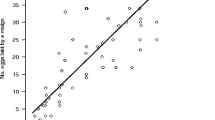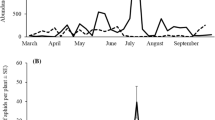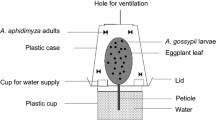Summary
Temporal changes in aphid abundance pose a considerable challenge to ovipositing aphidophagous ladybirds, as in order to maximize their fitness they need to synchronize their reproduction with the early development of aphid populations. Field census data and laboratory experiments were used to determine how ovipositing females of the two-spot ladybird, Adalia bipunctata (L.), assess whether an aphid population is suitable for exploitation. In the field, two-spot ladybirds usually laid eggs well before aphid populations peaked in abundance. In the laboratory they showed a marked reduction in their reproductive numerical response in the presence of larvae of their own species but not of other aphidophagous ladybirds. At the highest aphid density this was not a consequence of competition for food between larvae and ovipositing females. In the presence of conspecific larvae gravid females were very active and as a consequence more likely to leave an area, and when confined with other conspecific females or larvae laid fewer eggs and later than females kept on their own. The extent of the inhibition of egg laying is negatively correlated with the rate of encounter with larvae. Thus it is proposed that gravid females appear mainly to use the presence of conspecific larvae to assess the potential of an aphid colony for supporting the development of their offspring.
Similar content being viewed by others
References
Banks CJ (1957) The behaviour of individual coccinellid larvae on plants. Anim Behav 5:12–24
Bartlett BR (1978) Coccidae. In: Clausen CP (ed) Introduced parasites and predators of arthropods pests and weeds: a world review. Agricultural Research Service Handbook No. 480, USDA pp 57–74
Beddington JR, Hassell MP, Lawton JH (1976) The components of arthropod predation, II. The predator rate of increase. J Anim Ecol 45:165–185
Begon M, Harper JL, Townsend CR (1986) Ecology, Individuals, Populations and Communities, Blackwell, Oxford
Carter MC, Dixon AFG (1982) Habitat quality and the foraging behaviour of coccinellid larvae. J Anim Ecol 51: 865–878
Carter MC, Dixon AFG (1984) Honeydew: an arrestant stimulus for coccinellids. Ecol Entomol 9: 383–387
Carter MC, Sutherland D, Dixon AFG (1984) Plant structure and the searching efficiency of coccinellid larvae. Oecologia 63: 394–397
Crawley MJ (1975) The numerical responses of insect predators to changes in prey density. J Anim Ecol 44: 877–892
Dixon AFG (1959) An experimental study of the searching behaviour of the predatory coccinellid beetle Adalia decempunctata (L.). J Anim Ecol 28: 259–281
Dixon AFG (1970) Factors limiting the effectiveness of the coccinellid beetle Adalia bipunctata (L.) as a predator of the sycamore aphid, Drepanosiphum platanoides (Schr.) J Anim Ecol 39: 739–751
Dixon AFG (1985) Aphid ecology, Blackie, Glasgow and London
Evans EW, Dixon AFG (1986) Cues for oviposition by ladybird beetles (Coccinellidae): response to aphids. J Anim Ecol 55: 1027–1034
Fox LR (1975) Cannibalism in natural populations. Annu Rev Ecol Syst 6: 87–106
Godfray HCJ (1987) The evolution of clutch size in invertebrates. Oxford Surveys in Evolutionary Biology 4: 117–154
Gutierrez AP, Baumgaertner JV (1984) Modeling predation. In: Conway GR (ed) Pest and pathogen control; strategic, tactical and policy models. John Wiley and Sons, New York, pp 92–108
Hassell MP, Lawton JH, Beddington JR (1976) The components of arthropod predation, I. The prey death-rate. J Anim Ecol 45: 135–164
Hemptinne J-L (1989) Ecophysiologie d'Adalia bipunctata (L.) (Coleoptera Coccinellidae). Thèse de doctorat, Université Libre de Bruxelles
Hemptinne J-L, Naisse J (1988). Life cycle strategy of Adalia bipunctata L. (Col., Coccinellidae) in a temperate country. In: Niemczyk E, Dixon AFG (eds) Ecology and effectiveness of aphidophaga. SPB Academic Publishing, The Hague, The Netherlands, pp 71–77
Hemptinne J-L, Dixon AFG, Mackenzie A (1990) Adaptations du cycle biologique des prédateurs aphidophages aux fluctuations démographiques de leurs proies. In: Regulation des cycles saisonniers chez les invertébrés. Dourdan (France) (Les Colloques de l'INRA No 52) pp. 101–104
Hodek I (1973) Biology of Coccinellidae. Academia Press, Prague
Holling CS (1966) The functional response of invertebrate predators to prey density. Mem Entomol Soc Can 48: 1–86
Kan E (1988a) Assessment of aphid colonies by hoverflies, I. Maple aphids and Episyrphus balteatus (de Geer) (Diptera: Syrphidae). J Ethol 6: 39–48
Kan E (1988b) Assessment of aphid colonies by hoverflies, II. Pea aphids and 3 syrphid species: Betasyrphus serarius (Wiedemann), Metasyrphus frequens Matsumara and Syrphus vitripennis (Meigen) (Diptera: Syrphidae). J Ethol 6: 135–142
Kan E, Sasakawa M (1986) Assessment of the maple aphid colony by the hoverfly, Episyrphus balteatus (de Geer) (Diptera: Syrphidae). J Ethol 4: 121–127
Kareiva P (1990) The spatial dimension in pest-enemy interactions. In: Mackauer M, Ehler LE, Roland J (eds) Critical Issues in Biological Control. Intercept Ltd., Andover, UK, pp 213–227
Kareiva P, Odell G (1987) Swarms of predators exhibit “preytaxis” if individual predators use area-restricted search. Am Nat 130: 233–270
Mangel M (1987) Oviposition site selection and clutch size in insects. J Math Biol 2: 1–22
Mills NJ (1979) Adalia bipunctata (L.) as a generalist predator of aphids. Ph.D. Thesis, University of East Anglia
Mills NJ (1982) Voracity, cannibalism and coccinellid predation. Ann Appl Biol 101: 144–148
Nakamuta K (1987) Diel rhythmicity of prey-search activity and its predominance over starvation in the lady beetle, Coccinella septempunctata bruckii. Physiol Entomol 12: 91–98
Obrycki JJ, Tauber MJ (1981) Phenology of three coccinellid species: thermal requirements for development. Ann Entomol Soc Am 74: 31–36
Osawa N (1989) Sibling and non-sibling cannibalism by larvae of a lady beetle Harmonia axyridis Pallas (Coleoptera: Coccinellidae) in the field. Res Popul Ecol 31: 153–160
Parker GA, Courtney SP (1984) Models of clutch size in insect oviposition. Theor Popul Biol 26: 27–48
Price PW, Bouton CE, Gross P, McPheron BA, Thompson JN, Weiss AE (1980) Interactions among three trophic levels: influence of plants on interactions between insect herbivores and natural enemies. Annu Rev Ecol Syst 11: 41–65
Wratten SD (1973) The effectiveness of the coccinellid beetle Adalia bipunctata (L.) as a predator of the lime aphid Eucallipterus tiliae (L.) J Anim Ecol 42: 785–802
Wright ED, Laing JE (1980) Numerical response of coccinellids to aphids in corn in southern Ontario. Can Entomol 112: 977–988
Author information
Authors and Affiliations
Rights and permissions
About this article
Cite this article
Hemptinne, J.L., Dixon, A.F.G. & Coffin, J. Attack strategy of ladybird beetles (Coccinellidae): factors shaping their numerical response. Oecologia 90, 238–245 (1992). https://doi.org/10.1007/BF00317181
Received:
Accepted:
Issue Date:
DOI: https://doi.org/10.1007/BF00317181




